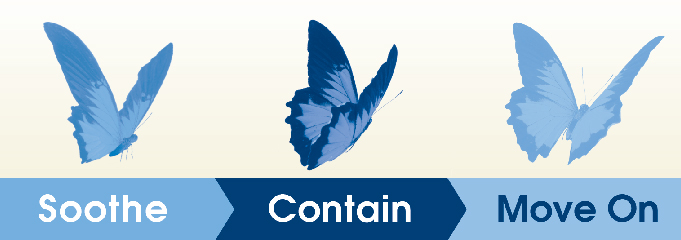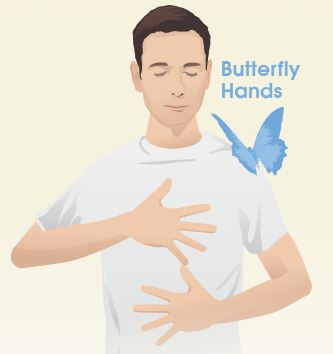
Soothe Contain Move On

This article was authored by Steve Stokes, Program Director at South Pacific Private (SPP). SPP is a Treatment Centre specialising in the integrated medical, psychiatric and psychotherapeutic treatment of addictions and mood disorders using an integrated approach to address the underlying core issues, trauma, and family dynamics which may have fuelled the development of the client’s presenting problem.
Awhile back, I had a conversation with a colleague who used to work with SPP. She told me outright that she was frustrated with our program. I was interested. I asked her why. She stated that we take the clients to their trauma, but do not teach them affect regulation skills. That the staff needed better training to support clients with a Body and Affect focused regulation technique that would support them in therapy and be a useful tool in their ongoing recovery. I left the conversation challenged and determined to create something new.
As a result of the seed planted from that conversation I developed Butterfly Hands-Soothe, Contain and Move on. This phrase had been around South Pacific Private for a while. We had been using Diaphragmatic Breathing as a way of regulating distressed clients for some time, combined with Motivational Interviewing techniques to help them move on from the moment once regulated. The challenge was to pull this together to make it a user friendly, easy tool for clients to learn to utilise quickly. As well as one that staff from reception to management would be able to teach and support clients with.
The Developmental Immaturity Model by Pia Mellody, which is the foundation of our work at SPP states that “childhood lack of nurturing, trauma, abuse and neglect through enmeshment and or abandonment causes Developmental Immaturity”. It is the effect of this trauma on our attachment system, and the resulting development of the brain that leaves us with regulation issues. In recovery we learn to self -esteem, set functional boundaries, becoming aware of our reality and how we interpret the world. From this data we become aware of our needs and wants and move to meet these appropriately with moderation. Basically, we are reconnecting with ourselves, instead of disconnecting. However, in the process of recovery we find that when we have affect regulation issues as a result of our trauma history, then learning to regulate when we become triggered is an essential, as the attempts to function get derailed -or as Dan Siegel puts it, “we flip our lid”. Talk Therapies at this Juncture are not effective, and Somatic focused therapies necessary for intervention and growth.
 Soothe Contain and Move On- Butterfly Hands, is a tool giving clients the opportunity to learn how to practice soothing the inner self when we get triggered into a regressive and chaotic reaction. Throughout a client’s stay at SPP, they have the luxury of reaching out for support from staff in the “Re-parenting role”. Trauma holds itself within the body and feeling states, and to heal it, we need a remedy that goes to the body, to Soothe our nervous system, to practice regulation skills, bringing the executive function of the brain back on line. One way we can assist this process is with “Butterfly Hands”, a mindful Somatic approach utilizing diaphragmatic breathing and sensual awareness of the self. When we go into the limbic Freeze reaction and chaos of that Wounded ego state, we need to Soothe our nervous system.
Soothe Contain and Move On- Butterfly Hands, is a tool giving clients the opportunity to learn how to practice soothing the inner self when we get triggered into a regressive and chaotic reaction. Throughout a client’s stay at SPP, they have the luxury of reaching out for support from staff in the “Re-parenting role”. Trauma holds itself within the body and feeling states, and to heal it, we need a remedy that goes to the body, to Soothe our nervous system, to practice regulation skills, bringing the executive function of the brain back on line. One way we can assist this process is with “Butterfly Hands”, a mindful Somatic approach utilizing diaphragmatic breathing and sensual awareness of the self. When we go into the limbic Freeze reaction and chaos of that Wounded ego state, we need to Soothe our nervous system.
Firstly placing our hands, one over our heart, the other over our diaphragm, with the thumb and the little finger touching. Then we focus on our breath mindfully, tuning into our body and its sensations, bringing coherence to our state which helps lift us into regulation. As Dr Porges states in the Polyvagal Theory, “the simple mechanical change in breathing increases the calming impact and health benefits of the myelinated Vagus on the body”. People who are chronically traumatized lack the ability to control the visceral feedback, and talk therapies at this moment of experience not only don’t help, but can be seen as another confirming trigger that the environment is an unsafe place, as Van Der Kolk outlines in his preface to Porges Polyvagal Theory text.
At this point in intervention and support, the focus cannot only be on the client, but needs to also be on a mindful awareness of our own state as the practitioner. Our voice, its tone and rhythm, our body language will be the foundation of the quality of the intervention and the promotion of the regulation. The simplicity of focusing on the breath provides a powerful somatic impact to the visceral feedback. From here we have access to our executive functioning adult skillset.
When triggered into a “flight or fight” response , our sympathetic nervous system is activated, as a result of the Dorsal vagus and we experience the rigidity of our adult adapted ego state as a response. From here our Contain skills are essential to keep us and others safe, and help us identify what is our reality. Defined by Pia Mellody, reality in simple terms is our Body-Thoughts-Feelings and Behaviours. Starting with our Body, it is the Dorsal Vagus reaction that circumnavigates us away from our Frontal Cortex and temporal lobes that help modulate our state, and all the meanings our neural pathways it assigns that determines our experience . So regulation of this state needs to happen first before we can even access our frontal and temporal lobes.
 Once regulated, our reality awareness will help us set boundaries so we can protect and contain ourselves as well as identify our unspoken needs and wants. Going to the Body, Diaphragmatic breathing to establish regulation and coherence, getting our executive function back on line allows us to check in and recognise what was the trigger?, what defence mechanisms were triggered?, what are our needs and wants right now? How can we best contain to support ourselves? Again the Mindful regulated presence of the therapist, creating an experience and atmosphere of safety goes a long way to dampen the sympathetic nervous system of the dysregulated client. Throughout the Flight Fight Freeze regulation the Subjective Units of Distress Scale is used to give clients a reference point that there state is actually beginning to change. It is a simple 0 =Feel relaxed to 10 = worse stress I have ever felt. This process of the client themselves being able to track ones stress when you are in an intervention, can in spite of what they feel , help them see progress.
Once regulated, our reality awareness will help us set boundaries so we can protect and contain ourselves as well as identify our unspoken needs and wants. Going to the Body, Diaphragmatic breathing to establish regulation and coherence, getting our executive function back on line allows us to check in and recognise what was the trigger?, what defence mechanisms were triggered?, what are our needs and wants right now? How can we best contain to support ourselves? Again the Mindful regulated presence of the therapist, creating an experience and atmosphere of safety goes a long way to dampen the sympathetic nervous system of the dysregulated client. Throughout the Flight Fight Freeze regulation the Subjective Units of Distress Scale is used to give clients a reference point that there state is actually beginning to change. It is a simple 0 =Feel relaxed to 10 = worse stress I have ever felt. This process of the client themselves being able to track ones stress when you are in an intervention, can in spite of what they feel , help them see progress.
The next phase is to Move On, taking responsibility for our recovery. It is the role of the Functional Adult to witness our internal reality and re-parent our inner ego states. Motivational Interviewing techniques are used to help a client move on with their ongoing recovery plan. We can use our sponsor or therapist for support with our re-parenting when outside of treatment. 12 Step Fellowships, ongoing therapy and therapy groups can also be used.
The brain is an amazing ally in the recovery process. We might be powerless over the effects of the Developmental Trauma initially, and the dysfunctional patterns that followed. However, recovery is about making more functional choices. By using the Mindfulness practice of Soothe Contain and Move On we can focus our awareness, and develop Functional Adult tools. Every time we utilize the tools, we are forming new neuro-pathways in recovery through neuroplasticity, as well as affecting the wiring of the existing connections due to neuro malleability. When this is all done in a safe secure environment, then these new neuro-pathways become super highways leading to the new way of life, one better than we have ever known.
As a trauma survivor and near thirty year veteran of recovery from addictions myself, the miracle that recovery offers to addicts and mental health clients is hard to explain. You get your life back. Soothe Contain Move On is just one of those opportunities where a practitioner gets to share the recovery road with their clients. This is a privilege.
In our weekly our Testimonial Ceremony at SPP, when clients move from their inpatient program into their ongoing recovery plan, we thank them for trusting us with their story. As you cannot help somebody up a hill, without getting a little closer to the top yourself.
